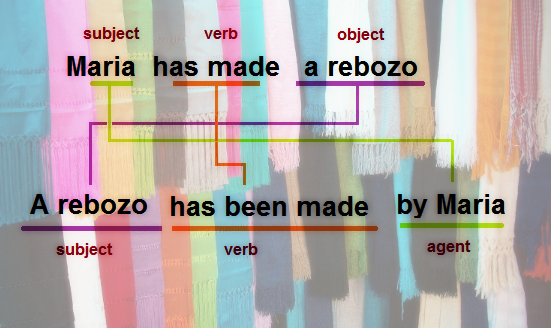In this topic, you will use the passive voice in the present perfect to describe the history of Mexican rebozo to emphasize actions in the past with a result in the present.

Ballesteros, A. (2017)
By the end of this topic, you will:
Use the passive voice present perfect to describe the history of Mexican rebozos to emphasize actions in the past with a result in the present.
Are you a clock man? An obsessed person with time? If your answer is no! Then, use the Present Perfect Tense! The exact time is not essential for you! Do you like to gossip? Are you one of those who do not like gossip? If you are not a gossip person, and if you do not care who did the action? Then, use the passive voice! If you care more about the result. Then, use the passive voice!

Grhul, T. (n.d.) Rebozos [photo]. Retrieved from: http://bit.ly/2thDrtM
The present perfect tense is used to say that an action happened at an unspecified time before now.

In the passive voice, what matters is the action and its result rather than who performed the action. It is not essential or not know who or what is performing the action.
For example, Rebozos have been made in Mexico. For example, Rebozos have been made in Mexico.
In the example above, the focus in on the fact that rebozos have been made (In Mexico). We do not know who made rebozos, and it is not essential.
If you want to know who made the action you must add: by
A rebozo has been made by Maria.
Subject + form of to be + Past Participle
It is important to note that when rewriting active sentences in the passive voice, the object of the active sentence becomes the subject of the passive sentence.
Example: Maria has made rebozos.
The object (rebozos) of the sentence in the active voice
becomes the subject of the sentence in the passive voice.
Example: Rebozos have been made (by Maria).

Ballesteros, A. (2017)

Activity 1

Ballesteros, A. (2017)
Who has worn rebozo?
Remember, what matters in passive voice is the action and its result rather than who performed it. It is not essential or not know who or what is performing the action.
The article must have 3 paragraphs. Each paragraph must have 5 lines.
Your article must have:
a) Name
b) Introduction
c) Development
d) Conclusion
Check the following www.wikihow.com Remember to use the passive voice in present perfect.
Please, make sure your description meets the elements and requirements of the rubric.

Activity 2
Santa María del Río is one of the most famous places to get a rebozo.
In the following text you will read about a brief history of the rebozo manufactured in Santa María del Río in San Luis Potosí.


Activity 3
In this activity, you will listen to an old lady talking about the history of the rebozo to her friend Elisa and inviting her to the rebozo festival in Santa María del Río in San Luis Potosí.
Click here to listen to the audio:


Ballesteros, A. (2017)

Activity 4
Remember that in the passive voice what matters is the action and the result of the action rather than who performed the action. It is not important or not known who or what is performing the action.
In this activity, you will record your voice telling a foreign person either the history of your experience wearing a rebozo. Use the passive voice in the present perfect.

Ballesteros, A. (2017)
Please, before you self-evaluate your description, make sure it has the characteristics contained in the rubric.
Now record yourself talking about the person you choose. You should speak for about one minute. Remember that you should give a short and organized speech, but it is not advisable to read it or say it from memory. Try to sound as fluent and natural as possible.

In this exercise, you will answer the rebozo history sentences using the passive voice in the present perfect.
• Learn English Grammar Retrieved from https://www.learnenglish.de/grammarpage.html
• Learn English British Council Retrieved from https://learnenglish.britishcouncil.org/es
• Present Perfect (2017) Retrieved from https://www.englishpage.com/verbpage/presentperfect.html
• Frances Spiegel (2014). The Rebozo in Art, Culture, and Fashion: Made in Mexico, Retrieved from https://decodedarts.com/the-rebozo-in-art-culture-and-fashion-made-in-mexico/1467
• La Casa de las Artesanías (2011) Historia El Rebozo en Santa María del Río. Retrieved from http://www.elrebozo.gob.mx/historia.html
• Rafael G. Córdoba (2014) Museo de Arte Popular Asociación de Amigos MAPEl Rebozo una Prenda de Identidad Mexicana. Retrieved from http://www.amigosmap.org.mx/2014/08/30/el-rebozo-una-prenda-de-identidad-mexicana/
• Dalia Ruiz Avila (2013)The Shawl a Mexican Symbol. Retrieved from http://www.pacarinadelsur.com/home/indoamerica/690-simbolo-mexicano-el-rebozo